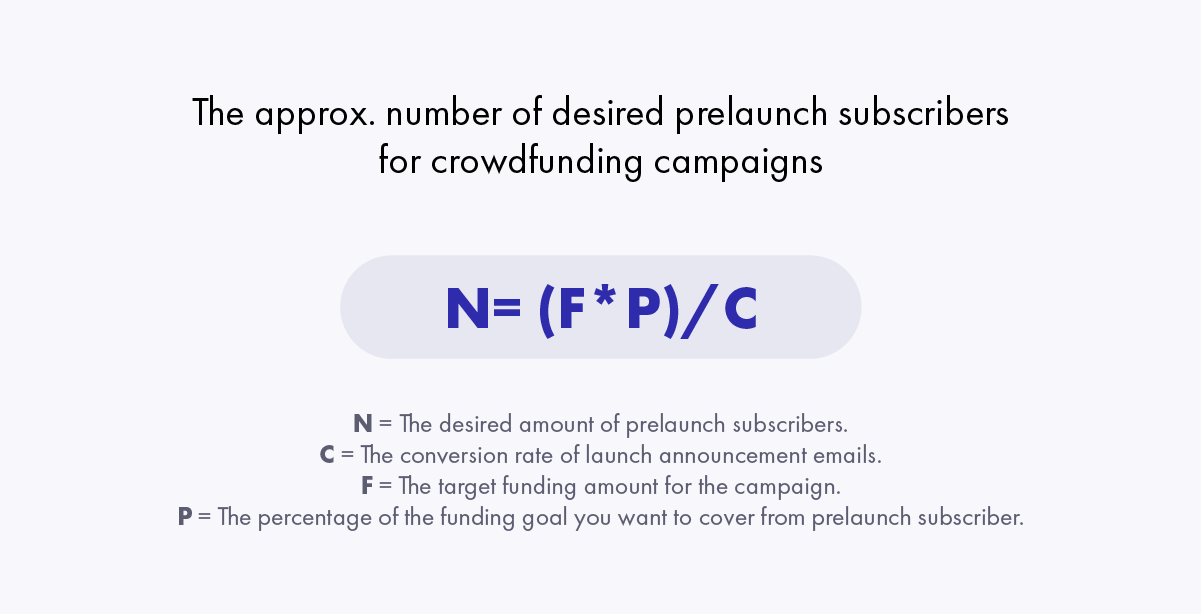Did you know that less than a third of crowdfunding campaigns reach their goal?
Although 33.33333% success rate is way better than 0%, you have to consider the amount of work required to launch a crowdfunding campaign:
- Coming up with an idea for a product.
- Doing a competitive analysis.
- Creating a prototype.
- Creating videos and shooting photos of the product.
These are man–hours and money that you’re never getting back if your campaign doesn’t reach the funding goal.
There are four main reasons why crowdfunding campaigns fail:
- Your product doesn’t resonate with your target customers.
- You failed to do efficient planning.
- The perks you offer to backers are not good enough.
- There was no early traction.
The way we see it, a successful crowdfunding campaign breaks down in three steps:
- Prelaunch for the crowdfunding campaign.
- Interaction with early adopters for feedback.
- Launch of the crowdfunding campaign.
Throughout this article, we’re going to take a look at how you can ensure that your crowdfunding campaign will get the early traction it deserves with a prelaunch campaign.
Setting the goals for the prelaunch of the crowdfunding campaign.
When you start a marketing effort without setting a goal, you become an aimless arrow.
Setting a goal for your campaign is important for many reasons:
- It provides focus.
- It keeps your team motivated.
- It pushes people to work together.
- Most importantly, it allows you to measure the success of your initiatives.
According to Indiegogo, launch announcement emails have an average of 5% conversion rate from subscriber to backer.
The main objective of a prelaunch campaign for a crowdfunding campaign is to provide immediate traction on the day of launch.
In the eyes of crowdfunding platforms, immediate traction means to attract many backers at a fast pace.
You need to aim high, that’s why you want to cover 30%-50% of the funding goal just from your prelaunch subscribers.
If:
- N= The desired amount of prelaunch subscribers.
- C= The conversion rate of launch announcement emails.
- F= The target funding amount for the campaign.
- P= The percentage of the funding goal you want to cover from prelaunch subscriber
You can calculate the approximate number of desired prelaunch subscribers with the following equation:
N= (F*P)/C

Since your campaign will offer different perks for a different amount of pledges, you can dive a bit deeper and set goals for every tier individually.
Choosing the right type of prelaunch campaign.
Since you’ve set a goal for the desired amount of prelaunch subscribers, it’s time to start thinking about how to attain it.
One option is to set up a landing page with a subscription form to simply gather email addresses.

Joeywears created a milestone referral campaign for their crowdfunding prelaunch.
By using a referral campaign with multiple rewards can really boost the number of subscribers for your prelaunch, because of the extra incentives provided.
Joeywears drove some of the email sign-ups from Facebook Advertising and managed to turn each sign up into 1.4 sign-ups, which cut the CPL.
Any type of referral campaign will work better than a simple form, but a Milestone referral campaign will probably maximize the results.
Creating your crowdfunding prelaunch campaign.
The heart of your prelaunch campaign is the landing page.
Distributing your prelaunch campaign might bring traffic, but success will be defined by the conversion rate of your page.
A converting prelaunch landing page for a crowdfunding campaign has:
- Simple and clear copywriting.
- Stunning visuals.
- Clear calls-to-action.
Copywriting.
Since you’re trying to convince people to invest in your product, you should try to communicate, not only what it is, but also what’s the value for subscribing to the prelaunch campaign.
Avoid using difficult language and passive voice as much as possible, and try to create a distinct brand voice.
People need to be intrigued by your tone, and at the same time, get the message fast and clear.
Design.
Simpler is better.
You don’t want to overload your prelaunch page with a tone of information. Design something that guides the eyes of the visitor towards your calls-to-action.
Make sure to include some photos or screenshots of your prototype. You’ll probably need to hire someone to photograph your product, or you can try to learn more about product photography.
Call-to-action.
Your calls-to-action is your final chance to persuade someone to subscribe to your prelaunch campaign.
You need something bold that provides instruction and incentive to the user. In other words, a great call-to-action provides the ‘how’ and the ‘why’.
Pilot managed to gather 30K email addresses from their prelaunch campaign. Their campaign became a huge success, as they raised $1M in 2 hours.
Pilot’s prelaunch landing page for their crowdfunding campaign. They raised $1M in 2 hours.

If you plan to go with the simple approach on building a prelaunch landing page (one subscription form, no rewards), all the major crowdfunding platforms offer solutions.
See:
- Setting up your Kickstarter project’s prelaunch page.
- Build a prelaunch landing page for your Indiegogo campaign.
In case you decide to use referral marketing for your prelaunch campaign, you should also consider the rewards you’re willing to offer.
You can always use some of the lowest tier perks from your crowdfunding campaign as an incentive for referrals.
e.g. Early access to the product, discounts for when the product will be available for sale.
Alternately, you could create an entirely new line of products that you can use as rewards.
Crowdfunding prelaunch distribution.
When you decide to build a product, it’s obvious that you believe in your idea and its potential to solve a problem.
However, having potential doesn’t guarantee anything at all.
Your product needs attention, and your prelaunch campaign can be used as a warm–up session for testing distribution channels for your final crowdfunding launch.
There are six distribution channels that you should explore:
- Social Media.
- Paid Advertising.
- Influencers.
- Content.
- Communities.
- PR.
Social Media and Paid Advertising.
If you have money to invest in advertising for your prelaunch, you should probably do it.
Paid advertising can give your campaign an initial boost, with the results being amplified by the viral loop in your sign up process.
But apart from the precise targeting option, social media offer a chance to eavesdrop on what your target audience talks about, and also create buzz by using organic means, like shares/comments/likes.
That kind of engagement is possible via asking engaging questions, or posting engaging content (e.g. great product photos/videos).
It’s really important to choose the right social media platforms, depending on what your potential backers use more.
Influencers.
Depending on your budget, you can choose to approach some of the following categories of influencers:
- Celebrities.
- Macro Influencers.
- Professionals.
- Micro–influencers.
I would propose to work your way up; start from micro-influencers as they are way cheaper, and their influence on their immediate circle can’t be ignored.
If you are lucky enough, some influencers might even approach you to review your product. Many YouTubers are always in the search for things to produce content about, so a lot of them review prototypes from crowdfunding campaigns.
The Kickstarter Kamlan 28mm F1.4 Lens Review
Content.
Even though writing for search engines takes up to a few months to start bringing traffic, your prelaunch period is an excellent opportunity answering questions that your audience might have in the form of SEO articles.
Prior to the prelaunch campaign, you should conduct keyword research, and find out what your competition does, and also discover keywords relevant to your product that you could rank for.
Communities.
Engaging with communities is a difficult task. It takes time and you need to be persistent.
That being said, being an active member in communities closely related to your product is a chance to open conversation, build trust, and eventually promote your prelaunch campaign.
PR.
A successful public relations strategy is really valuable when one tries to launch a new product or company.
In order to nail it, you need to know the ins and outs of not only gaining coverage in top outlets but maintaining relationships with the top journalists in your industry so that you get the coverage you deserve.
For many people (including me), that sounds like an impossible task.
That’s why it’s wiser to hire a PR agency to do it for you. There are tons of agencies out there- some of them specialize in crowdfunding campaigns, so make sure to do your research before deciding as this could be quite expensive.
Before you go.
The crowdfunding community is not likely to donate to your project unless it’s already a success from the very beginning.
That’s why creating a prelaunch for your crowdfunding campaign is an absolute must.
You always have to keep in mind that you need to start your official launch with a number of people waiting to back you up.
Good luck!
Apostle Mengoulis
Apostle is a core member of the founding team at Viral Loops. He has worked closely with hundreds of referral marketing campaigns made with Viral Loops. Apostle has years of experience in growing and marketing companies and co-founded Growth Hacking University.

2 comments
This is an outstanding article. Thanks for all the suggestions!
While planning for a successful crowdfunding campaign, the key thing which is often overlooked is a grand prelaunch! Thanks for explaining it so simply and vividly!